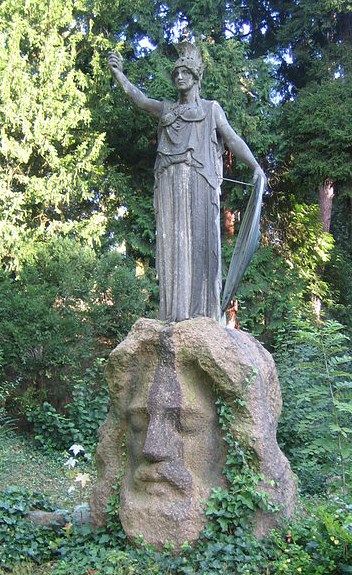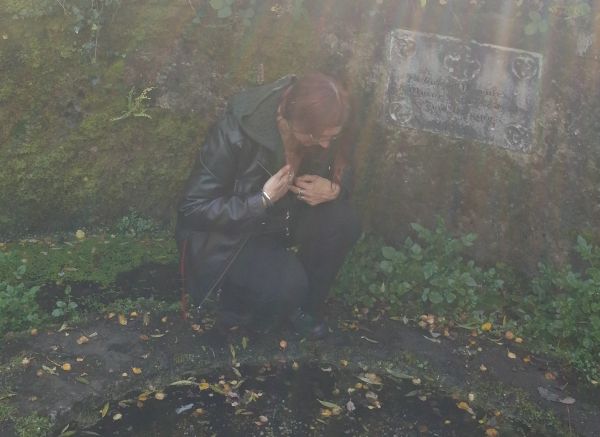
She is nasty, this child-killing, hairy-legged demoness. Terrifying men, women and children for a couple of thousand years. So much so that special incantation bowls were made to protect households against her, women were warned not to leave their husbands or children alone in a house in case she came and prayer circles inscribed with angels’ names were drawn around cribs. She is mentioned only once in the Old Testament (and that, a later addition in order to fix up an inconsistency) and yet – what a lot of power she held to terrify! What exactly is her story?
If anyone has heard, even glancingly of Lilith, it would be in this context: that the Book of Genesis states that God made a man and woman out of earth. (Genesis I:27 “So God created man in His own image, male and female He created them.”) Not a woman created from Adam’s rib, but both created at the same time. Later in Genesis, Eve makes her appearance (Genesis II: 18 “And Yahweh said, ‘It is not good for Adam to be alone. I will make a fitting helper for him”, Genesis II: 22 “And Yahweh fashioned the rib that He had taken from the man into a woman and He brought her to the man.”)
Around 500 – 600 C.E., the rabbinical scholars who sought to see the Holy Word as the Truth without contradiction or loopholes, began to have difficulty with these passages. Engaged in a learned pursuit called “Midrash” (meaning “to root out or investigate”), they attempted to resolve the discrepancy in Genesis by trying to fill in gaps. Even looking to similarities of words to find connections with other stories that may make the passages resolve. It seemed clear that Genesis was talking about 2 different women and so the rabbis of the time looked back through past biblical writings, settling on the Book of Isaiah which had a story of a woman who seemed to fit: Lilith.
The Book of Isaiah is a book of prophecy written about 742 – 701 B.C.E. by the Prophet Isaiah. Much of the Book of Isaiah is involved with encouraging God’s people to avoid those who worship other deities and to express God’s anger at the destruction of Jerusalem in 587 B.C.E. by those aforementioned foreigners. It is in describing the resulting desolation of the land that Lilith appears. (Isaiah 34: 14 “The land shall become burning pitch. Thorns shall grow over its strongholds. It shall be the haunt of jackals. There too the lilith shall repose and find herself a resting place.”)
It was known that the Book of Isaiah was referring to a Sumero-Babylonian female figure. It is suspected that the figure in question was so familiar in those times as to not need further elaboration. The “lilith” in question appears to be the Sumerian wind demon. There is a reference to a lilith in the Babylonian Epic of Gilgamesh. There are many versions of this epic story of a possible ancient king, found written on clay tablets dating between 2150 – 1000 B.C.E. Interestingly (in light of the biblical explanation that was to evolve), the part that seems to concern Lilith has to do with a demanding sexual partner, but it is the Goddess Inanna rather than Lilith who is making the demands. The story goes that Gilgamesh (the great Babylonian king) wanted to have sex with Inanna but she refused. In some versions she out and out refuses. In others she promises to have sex with Gilgamesh if he can complete a task. Regardless, at some point a sacred tree is cut down which has 3 beings in it: a bird, a snake and Lilith, the handmaiden of Inanna, in the centre in a house which she built. When the tree is cut down these beings have to flee. Lilith is said to have fled to the desert.
The scholarly rabbis from the 7th century C.E. seem to have grasped this image of Lilith, combining the 3 beings into 1: a being with long flowing hair, wings and talons like a bird (as pictured in the fresco) and even (later in history) being imaged with a snake’s body.
It is from this time that Lilith transforms from being the wind demon of the past into the terrible sexually threatening being that held mythic imagination up until the 20th century. In a book known as The Alphabet of Ben Sira containing 22 episodes (to correspond to the 22 letters of the Hebrew alphabet) the story of Adam and Lilith became fleshed out.
God made Adam and Lilith at the same time from earth. But in the sexual politics of the time, Adam wanted to take the male superior position during sexual activity and Lilith wanted nothing to do with it. Her attitude was basically that, as they were created at the same time, there was no need for her to take an inferior position. She did not want Adam on top of her, sexually, metaphorically or symbolically. As there was no working through this first of all relationship conflicts, Lilith decided to leave. She took off for the Red Sea (rather than the desert) and had sex with whomever she wanted, giving birth to a number of children (called “lilim”). Adam was not happy about this and appealed to God who sent 3 angels (Sanvi, Sansanvi and Semangelaf) after Lilith to get her back. But when she found out that it meant she’d have to accept the male superior sexual position, she declined. The angels punished her by exterminating almost all her sons and dooming her to lose 100 children a day. Lilith swore revenge on all sons of man. However, to prevent being drowned in the sea by the angels, Lilith agreed that she would not harm any child who wore an amulet bearing her name.
That ended the relationship between Adam and Lilith. And Adam had to make do with having sex with animals until he got tired of that and asked God for another wife, saying that all the other animals had mates of kind and so he should have as well. But God wasn’t going to make the same mistake of having the potential ‘equal rights’ argument come up again so this time he fashioned a wife out of one of Adam’s rib. The question of being made of equal stuff was now a non-issue. And things went along fairly well until the whole snake incident. Interestingly (as pictured below in Michaelangelo’s version of “The Fall”), there are some ties back to Lilith in this. That the snake was another version of Lilith trying to muck things up for Adam. Or, taken a different way, the snake was another version of Lilith trying to help Eve to gain some empowerment of her own. (Clearly I have taken a few liberties in the language of the retelling but the facts hold as related in versions of The Talmud and The Alphabet of Ben Sira)

From this point on, Lilith truly gained ground as being a terrible beast who kills children in their cribs, has poison instead of milk in her breasts and will steal the seed of men while they sleep (i.e. the succubae of ancient times or the wet dreams of modern times). Several hundred years after The Alphabet of Ben Sira, the book that forms the basis of kabbalistic inquiry known as the Zohar, took her evilness to a new low. Though it expanded somewhat on the previous notion (added a further atrocity that Lilith actually uttered the name of God, Yod He Vau He in order to leave for the Red Sea which harkens to the story of Isis learning and using the name of Ra to gain power over him), the main addition to the Lilith story was to partner her with the male personification of evil named as either Samuel or Asmodeus. This resulted in the somewhat confusing explanation that there were actually 2 Liliths. The great Lilith, spouse of Samuel and the little Lilith, spouse of Asmodeus. Regardless of whether there were one or two, Lilith coupled with the male personification of evil made for a truly nasty piece of work.
Lilith’s myth grew through the centuries to create the image of a creature who was outside the realm of Divine grace, who actively defied and insulted God and worked viciously to destroy the children of man who were God’s people. But, was it all a mistake of translation? It is from the Sumero-Babylonian stories of Lilith that some hint of what she became mythologically is derived. About 4000 B.C.E. there were references to “lilitu” in Sumer, referring to wind or storm demons. This follows through with the Sumerian word “lil” meaning “air”. There was a well-known (for the times) Goddess of Sumer named “Ninlil” which literally translated as “Lady Air”. But the proto-Semitic language (or ancient Hebrew) had the word “lyl” which translated as “night”. There were also, in ancient Babylonia, the “lilitu” who appeared to men in erotic dreams. Interestingly, they were balanced by the stories of the Babylonian Gilgamesh’s father, named “Lillu” who was said to disturb the sleep of women. It is not a stretch to see how the meanings such as “night” and “air” coupled with stories of creatures who interrupted the sleep through sexual visions could end up, over time, coalescing into the myth of a night demon who preys on men and children. Particularly if this comes at a time when sexuality is beginning to be quite regulated and rule-oriented and fears over child mortality rates are fairly high.
It has been a long time coming, but in recent years Lilith has been going through a change in mythological persona. Largely in response to the revisiting and reclaiming that has been the result of the 20th century Jungian analytical psychology movement and the women’s movement, the more demonic aspects of Lilith have been left by the wayside. Rather than be seen as a monster, she is seen as our Shadow side, everything that our society frowns upon, but that needs to be acknowledged, embraced and accepted in a healthy way in order to avoid causing chaos and destruction in our lives. She is seen as the voice of strong and wronged women everywhere, those whom others have attempted to silence but who have refused to go down without a fight.
Considering the Jungian perspective of Lilith as Shadow, one very interesting example of her appearance is the astrological: in the form of the Black Moon. According to the website, www.astro.com , the Black Moon occurs because an ellipse has 2 focal points (whereas as true circle has just one). In the passage along the Moon’s ellipse, it is the Earth that occupies one focal point. The other focal point is named the Black Moon or Lilith. It occupies the place around which the Moon is the farthest point from Earth, reaching out towards the Sun.

If taken into consideration in a chart, the Black Moon Lilith represents the furthest reaches of our Unconscious selves. The Moon itself represents the Unconscious so the Black Moon must represent that which is truly buried deep. Interestingly, there is a sense that it from this place, if explored and embraced, that we can move towards our greatest alignment with Spirit. This is reflected astrologically in that it is when the Moon is traveling in the domain of the Black Moon focal point that it is indeed closest to the Sun, the symbol of enlightenment, empowerment, vitality and true expression of Self.
One of the most beautiful contemporary illustrations of the positive reclaiming of Lilith’s empowering energy comes in the form of the Lilith Fair Concert Tours of the late 1990’s. Started by Sarah MacLachlan in response to frustration over concert promoters’ belief that having 2 female acts in a row at an event spelt death to ticket sales, the 3 Lilith Fairs (that consisted solely of female music acts) raised over $10 million for women’s charities and in 1997 was the top grossing summer concert tour of the year. There is word that the Lilith Fair will return in 2010 with concert dates in Europe.
As we started with Genesis, it seems only fitting to end with Genesis as well. However, continuing along with Lilith’s expression in the musical world… In what is (in my opinion) one of the greatest albums ever, “The Lamb Lies Down on Broadway”(1974), there is a song tribute to Lilith, seemingly referring back to her days as handmaiden of Inanna, as she guides the hero of the song-cycle through darkness into light.
The chamber was in confusion – all the voices shouting loud
I could only just hear a voice quite near say
“Please help me through the crowd”
‘Said if I helped her through she could help me too
But I could see that she was wholly blind
But from her pale face and her pale skin
A moonlight shined.
Lilywhite Lilith
She’s gonna take you through the tunnel of night
Lilywhite Lilith
She’s gonna lead you right.
When I led her through the people, the angry noise began to grow
She said “Let me feel the way the breezes blow
And I’ll show you where to go”
So I followed her into a big round cave, she said,
“They’re coming for you, now don’t be afraid”
Then she sat me down on a cold stone throne, carved in jade.
Lilywhite Lilith
She’s gonna take you through the tunnel of night
Lilywhite Lilith
She’s gonna lead you right.
She leaves me in the darkness,
I have to face my fear,
And the darkness closes in on me
I can hear a whirring sound growing near.
I can see a corner of the tunnel
Lit up by whatever’s coming here.
Two golden globes float into the room
And a blaze of white light fills the air…
Lilith has truly spent many thousands of years traveling the dark path of rejection and castigation, being hated, feared and maligned. Through all the stories, she has held a power to tell the truth as she sees it, to embrace sexuality in a form that appeals to her and to refuse to bow to an authority that tries to rule her. And yet, she has wings and is described as beautiful.

Lilith can certainly be feared. As the one who has the ability to lead us to see that which is buried deep in our Unconscious – our animal natures, our unbridled sexuality and passion, our rejected selves – the path she leads us on can be truly unnerving. And yet, like the snake she embraces (or embodies), she can lead us to the cave that will act as the womb to our transformation.
My favorite vision of Lilith is the story in which she goes back to the Garden of Eden and holds her hand out to Eve. In my mind she is saying, “Come on, Sister. Let’s get out of this goddess-forsaken place. It’s got you a bit brain-washed and you have so much more to offer.”
Audio-visual Resources:
“Banned from the Bible” documentary on History Channel
Book Resources:
Stone, Merlin Ancient Mirrors of Womanhood Beacon Press 1979
Walker, Barbara G. The Woman’s Encyclopedia of Myths and Secrets Harper Collins 1983
Website Resources:
http://www.asphodel-long.com/html/lilith.html
http://www.bib-arch.org/e-features/lilith.asp
http://lilith.abroadplanet.com/index.html
http://www.astro.com/astrology/in_lilith_e.htm
Some books I have not read but found recommended on the “abroadplanet” website and which look really interesting:
Kotluv, Barbara Black The Book of Lilith Samuel Weiser 1986
(Jungian feminist interpretation of Lilith legends)
Patai, Raphael The Hebrew Goddess Wayne State University Press 1990
(Delves into not only Lilith but Asherah, Astarte and others)
Schwartz, Howard Lilith’s Cave Harper & Row 1990
(Collection of Jewish folk tales centering not only on Lilith but other related figures like the Queen of Sheba)
A novel I have read and highly recommend:
Cunningham, Elizabeth The Wild Mother Station Hill Press 1993
(The story of Lilith, one of the descendants of the original Lilith who lives in the “Empty Land”, but is seduced by and seduces the alchemical professor, Adam Underwood who lives in the nearby walled mansion. As Adam uses the daughter that results from their union to try to recapture her, Lilith begins to die and fights to regain her freedom and her daughter.)



